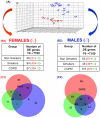Systemic inflammatory response to smoking in chronic obstructive pulmonary disease: evidence of a gender effect
- PMID: 24830457
- PMCID: PMC4022517
- DOI: 10.1371/journal.pone.0097491
Systemic inflammatory response to smoking in chronic obstructive pulmonary disease: evidence of a gender effect
Abstract
Background: Tobacco smoking is the main risk factor of chronic obstructive pulmonary disease (COPD) but not all smokers develop the disease. An abnormal pulmonary and systemic inflammatory response to smoking is thought to play a major pathogenic role in COPD, but this has never been tested directly.
Methods: We studied the systemic biomarker and leukocyte transcriptomic response (Affymetrix microarrays) to smoking exposure in 10 smokers with COPD and 10 smokers with normal spirometry. We also studied 10 healthy never smokers (not exposed to smoking) as controls. Because some aspects of COPD may differ in males and females, and the inflammatory response to other stressors (infection) might be different in man and women, we stratified participant recruitment by sex. Differentially expressed genes were validated by q-PCR. Ontology enrichment was evaluated and interaction networks inferred.
Results: Principal component analysis identified sex differences in the leukocyte transcriptomic response to acute smoking. In both genders, we identified genes that were differentially expressed in response to smoking exclusively in COPD patients (COPD related signature) or smokers with normal spirometry (Smoking related signature), their ontologies and interaction networks.
Conclusions: The use of an experimental intervention (smoking exposure) to investigate the transcriptomic response of peripheral leukocytes in COPD is a step beyond the standard case-control transcriptomic profiling carried out so far, and has facilitated the identification of novel COPD and Smoking expression related signatures which differ in males and females.
Conflict of interest statement
Figures





References
-
- Vestbo J, Hurd SS, Agusti AG, Jones PW, Vogelmeier C, et al. (2013) Global Strategy for the Diagnosis, Management and Prevention of Chronic Obstructive Pulmonary Disease, GOLD Executive Summary. Am J Respir Crit Care Med 187: 347–365 rccm.201204-0596PP [pii];10.1164/rccm.201204-0596PP [doi] - DOI - PubMed
-
- Silverman EK, Speizer FE, Weiss ST, Chapman HA Jr, Schuette A, et al. (2000) Familial aggregation of severe, early-onset COPD: candidate gene approaches. Chest 117: 273S–274S. - PubMed
Publication types
MeSH terms
Substances
LinkOut - more resources
Full Text Sources
Other Literature Sources
Medical
Molecular Biology Databases

